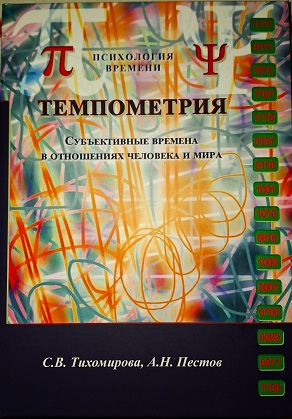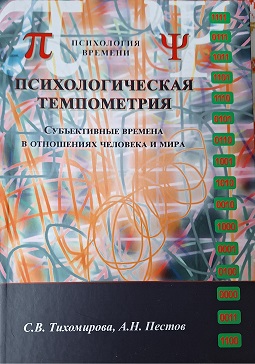Tempometry in the Psychology
Space & Geometry, Time & Tempometry

Key phrase and key words:
Geometry for space, Tempometry for subjective times
Metrics of semantic space and tempometrics of subjective time
From model for the temporal pacemaker to model of dipole.
Dipole model of subjective time frequency emitter
Producing equal intervals
Proper equilateral triangle & Proper equilateral triduration
Tempogram of equal intervals with pauses
anisotropic discontinuous continuity
Sheaf of vectors subjective times
Collinearity of subjective times
The approach of the moment which is tensely awaiting
Impossibility within the time to be in future and go out from present instant (now)
Up gradient of agitation, the strength of desire and the frequency of subjective time are interrelated
Dialectic by Rubinstein S.L.
The Frequency of Subjective time
The Agitation
Seemness of equivalence
Acceleration, deceleration
Aristotelian concept of time
Tempometry for time
Tense Vector
Strain of subjective time
Tension
Tensor
Boolean matrices as frame of psychology
Orientation in subjective times
Producing Either Equal Intervals methods E E I P
Tempograms
Levels of psychical reflection in accordance with Itelson L.B.Future in the present time
The present instant
Vector expectancy theory - VET
темп временной перспективы
наполненность временного интервала
The dimensionality of each separate subjective time is 2
Laboratorial time is analogous to cleanness of test-tube in chemistry laboratory
one tick pacemaker
subsecond
Disequalduration (Дисиквалдюрейшен).
Tempometrical numbers "psi" - ∞ < Ψ < +∞
Preferred point in time- "now"
The touch-phase, defined as the time between onset and offset of the finger tap.
The off-phase, the period between offset and onset.


The Annotation
The content of the book demonstrates the development of S.
L. Rubinstein's scientific ideas about orientation in time, focusing on the
concepts of vector, fluid dialectic of time definitions, stresses, the law of
filled time intervals, the law of emotionally deterministic estimation of time,
the coordinate system of units of measurement tied to the natural starting
point, which is the present moment, the priority setting for the future in the
present moment of time. Historically, psychology
has considered in detail the perception of time at one of the levels of mental
reflection - the level of sensations. This book develops fruitful distinctions
about the levels of mental reflection of the world and oneself in the world,
conducted by L. B. Itelson. Subjective tenses are considered
with an emphasis on the formal level of psychological reflection using Boolean
algebra. The final, square matrix is a representation of a mental quantity,
which is set as a subjective estimate of the speed of approximation of the
desired. Innovations have been introduced
into well-known research methods. The distinctive novelty of the paradigm used
is the emphasis on outward direction, from the subject to the object, instead
of the perception of time - its production. There is also an important
significant update to the experimental method used: experiments investigate not
only intervals of subjectively equal duration, but also pauses between interval
counts. The reciprocity of moving averages in the intervals and pauses of
subjective clocks has been established with the interpretation of the mental
content of this reciprocity. In contrast to both descriptive and statistical
approaches, the results of applying classical mathematical methods of
processing the results are presented. It
is precisely metachronal waves in sequences of subjectively equal durations
that have been identified. A distinction is made between meta-step and
metachronal waves and their correct distinction is substantiated. The
unevenness of the numerical series has been experimentally confirmed 0 1 2 3 4
5 6 7 8 9 10 11... in the Aristotelian concept of time. The
laboratory time of psychological research is separately allocated. New
auxiliary models of subjective tenses are proposed. A well-known collection of 30
articles “Subjective time: the philosophy, psychology, and neuroscience of
temporality”, © 2014 Massachusetts Institute of Technology, edited by Valtteri
Arstila and Dan Lloyd. It presents a broad scientific perspective on the
subjective time of foreign authors. Psychological tempometry can be considered
as a worthy addition to these long-term studies, since the contents of the book
are distinguished not by a retelling with adaptation of well-known Western
methods and approaches to the topic, but by their own perspective on the topic
of aspirations.
Оглавление
Глава 1
1.1.
1.2.
1.3.
1.4.
Глава 2
2.1.
2.2.
2.3.
2.4.
2.5.
2.6. Временная перспектива.
2.7. Четыре
параметра временной перспективы
в ее динамическом развитии. Изменяющийся
тензор
2.8.
2.9. Особенность
естественной, собственной координатной системы
2.10.
2.11.
2.12.
2.13.
2.14.
2.15.
Глава 3
Пространство и геометрия, время и
темпометрия.
3.1. Геометрия
и темпометрия. Геометризация мира
и субъективное мероопределение личности
во времени жизни.
3.2.
3.3.
3.4.
3.5.
3.6.
3.7.
3.8.
3.9. Ценность
темпометрии в спорте, торговле
3.10.
3.11. Значение
темпометрии для экономики.
3.12.
3.13.
3.14.
3.15.
3.16.
Глава 4
4.1.
4.2.
4.3. Операциональные определения
4.4.
4.5.
Глава 5
5.1.
5.2.
5.3.
5.4.
Глава 6
6.1.
6.2.
6.3.
6.4.
6.5.
6.6.
6.7.
6.8.
6.9. Правильный
равносторонний треугольник
6.10.
6.11.
6.12.
6.13.
6.14.
6.15.
6.16.
6.17. Основания, положенные
6.18.
6.19.
6.20.
6.21.
6.22.
6.23. Выведение
из теории метода
6.24.
6.25.
6.26.
Глава 7
7.1.
7.2. Новизна, оригинальность
7.3.
7.4.
7.5.
7.6.
7.7.
7.8.
7.9.
Глава 8
Глава 9
9.1.
9.2.
9.3.
9.4.
9.5.
Глава 10
10.1.
10.2. Особенность
координатной системы
10.3.
10.4. Темпометрический ракурс
10.5.
10.6. Формализация
посредством матричного
10.7.
10.8.
10.9. Темпометрика
субъективного времени
10.10.
10.11. Формализация
семантического пространства
10.12. Качественные определенности
10.13.
10.14.
10.15.
10.16.
10.17.
10.18.
10.19.
10.20.
Глава 11
Глава 12
Глава 13
Качества переживаний
13.1.
13.2.
13.3.
Глава 14
Глава 15
15.1.
15.2. Взаимность
скользящих средних в интервалах и паузах
15.3.
15.4.
15.5.
15.6.
15.7.
Глава 16
16.1.
16.2.
16.3.
16.4.
16.5.
16.6.
16.7. Поиски устойчивых отношений
16.8.
16.9.
16.10.
16.11.
16.12.
Глава 17
1/F Fluctuation on Appearance in Tapping Rhythms 287 Вопрос о природе дрейфа.
The Production a Subjective Times via Induction 291
Masashi Yamada and Takashi Tsumura,
Phenomena of Guy Madison 292
Takashi Ogawa and Junko Kusano.
Phenomena of M. Yamada and T. Tsumura
Глава 18
К дискуссии по моделям субъективного времени 298
Полезные пространственные и энергетические аналогии 310
Дипольная модель
Ваше время 318
К
125-летию исследований субъективных времен.
Влияние когнитивных нагрузок на оценку
Переживание
времени: механизмы нервной системы
Психологическая темпометрия. Субъективные времена в
отношениях человека и мира. – М. Эдитус, 2025. -536 с.
Аннотация
Содержание книги демонстрирует развитие научных идей С.Л.
Рубинштейна об ориентации во временах, с фокусированием на понятиях вектора,
текучей диалектики временных определений, напряжений, законе заполненных
временных отрезков, законе эмоционально детерминированной оценки времени,
координатной системе единиц измерений, привязанной к естественной отправной
точке, коей является настоящее мгновение, приоритетной установке на будущее в переживаемом в
настоящем мгновении времени.
В психологии, исторически, подробно рассмотрено восприятие
времени на одном из уровней психического отражения - уровне ощущений. В этой
книге развиваются плодотворные разграничения об уровнях психического отражения
мира и себя в мире, проведенные Л.Б.Ительсоном.
Субъективные времена рассматриваются с акцентом на
формальном уровне психического отражения с использованием булевой алгебры.
Конечная, квадратная матрица является представлением психической величины,
которая задается как субъективная оценка быстроты приближения желаемого.
Введены новации в известные методы исследований.
Отличительная новизна используемой парадигмы в акцентировании на направление
вовне, от субъекта к объекту, вместо восприятия времени - его продуцирование.
Также есть важное существенное обновление используемого экспериментального
метода: в экспериментах исследуются не только интервалы в отсчете субъективно
равных длительностей, но и паузы между отсчетами интервалов. Установлена
взаимность скользящих средних в интервалах и паузах субъективных часов с
расшифровкой психического содержания этой взаимности. В противовес как
описательным, так и статистическим подходам предоставлены результаты применения
классических математических методов обработки результатов.
Выявлены именно метахрональные волны в последовательностях субъективно
равных длительностей. Проведено различие между меташаговыми и метахрональными
волнами и обосновано их корректное различие. Экспериментально подтверждена
неравномерность числового ряда 0 1 2 3 4 5 6 7 8 9 10 11…в Аристотелевом
понятии времени.
Отдельно выделено лабораторное время психологических
исследований. Предлагаются новые вспомогательные модели субъективных времен.
Известен сборник из 30 статей “Subjective time: the philosophy, psychology, and neuroscience of temporality”, © 2014 Massachusetts Institute of Technology, edited by Valtteri Arstila and Dan Lloyd. В нем представлен широкий научный ракурс на субъективное время зарубежных авторов. Психологическую темпометрию можно рассматривать как достойное дополнение к этим многолетним исследованиям, поскольку содержимое книги отличает не пересказ с адаптацией известных западных методов и подходов к теме, а собственный ракурс на тему устремлений человека со стороны его субъективных времен.
